I am a newbie to using POI at work.Now i'm going to use POI in java to read a bar chart in the PPT.I've added several series x to it in advance,which are the column headers of the excel to which the bar graph belongs. But i can only read the first three columns by default with the POI.In addition,once I modify the column header of the bar chart,or want to add a fourth column(thar is,add a color)to a bar chart with only three columns, the bar chart cannot be edited when I open the PPT,indicating that the node of the bar chart is damaged. So is there a master who can help talking how to use POI to prroperly add a color to the bar chart(add a series)?
Eg: when I debug to the " long ptCatCnt = catDataSource.getStrRef().getStrCache().getPtCount().getVal(); It show nullpointerexecption, I don't know how structure in ppt the bar-chart is.So I want know how to update the bar-chart。
The code is :
public class PPTDemo {
public void run() {
try {
SlideShow slideShow = SlideShowFactory.create(new File("./res/1.pptx"));
for (Object o : slideShow.getSlides()) {
XSLFSlide slider = (XSLFSlide) o;
// 第一页
if (slider.getSlideNumber() == 1) {
for (POIXMLDocumentPart.RelationPart part : slider.getRelationParts()) {
POIXMLDocumentPart documentPart = part.getDocumentPart();
// 是图表
if (documentPart instanceof XSLFChart) {
XSLFChart chart = (XSLFChart) documentPart;
// 查看里面的图表数据,才能知道是什么图表
CTPlotArea plot = chart.getCTChart().getPlotArea();
// 测试数据
List<SeriesData> seriesDatas = Arrays.asList(
new SeriesData("", Arrays.asList(
new NameDouble("行1", Math.random() * 100),
new NameDouble("行2", Math.random() * 100),
new NameDouble("行3", Math.random() * 100),
new NameDouble("行4", Math.random() * 100),
new NameDouble("行5", Math.random() * 100)
)),
new SeriesData("", Arrays.asList(
new NameDouble("行1", Math.random() * 100),
new NameDouble("行2", Math.random() * 100),
new NameDouble("行3", Math.random() * 100),
new NameDouble("行4", Math.random() * 100),
new NameDouble("行5", Math.random() * 100)
))
);
XSSFWorkbook workbook = chart.getWorkbook();
XSSFSheet sheet = workbook.getSheetAt(0);
// 柱状图
if (!plot.getBarChartList().isEmpty()) {
CTBarChart barChart = plot.getBarChartArray(0);
updateChartExcelV(seriesDatas, workbook, sheet);
workbook.write(chart.getPackagePart().getOutputStream());
int i = 0;
for (CTBarSer ser : barChart.getSerList()) {
updateChartCatAndNum(seriesDatas.get(i), ser.getTx(), ser.getCat(), ser.getVal());
++i;
}
}
// 饼图
else if (!plot.getPieChartList().isEmpty()) {
// 示例饼图只有一列数据
updateChartExcelV(Arrays.asList(seriesDatas.get(0)), workbook, sheet);
workbook.write(chart.getPackagePart().getOutputStream());
CTPieChart pieChart = plot.getPieChartArray(0);
int i = 0;
for (CTPieSer ser : pieChart.getSerList()) {
updateChartCatAndNum(seriesDatas.get(i), ser.getTx(), ser.getCat(), ser.getVal());
++i;
}
}
}
}
}
}
try {
try (FileOutputStream out = new FileOutputStream("./res/o1.pptx")) {
slideShow.write(out);
}
} catch (FileNotFoundException e1) {
e1.printStackTrace();
} catch (IOException e1) {
e1.printStackTrace();
}
} catch (IOException e) {
e.printStackTrace();
} catch (InvalidFormatException e) {
e.printStackTrace();
}
}
/**
* 更新图表的关联 excel, 值是纵向的
*
* @param param
* @param workbook
* @param sheet
*/
protected void updateChartExcelV(List<SeriesData> seriesDatas, XSSFWorkbook workbook, XSSFSheet sheet) {
XSSFRow title = sheet.getRow(0);
for (int i = 0; i < seriesDatas.size(); i++) {
SeriesData data = seriesDatas.get(i);
if (data.name != null && !data.name.isEmpty()) {
// 系列名称,不能修改,修改后无法打开 excel
// title.getCell(i + 1).setCellValue(data.name);
}
int size = data.value.size();
for (int j = 0; j < size; j++) {
XSSFRow row = sheet.getRow(j + 1);
if (row == null) {
row = sheet.createRow(j + 1);
}
NameDouble cellValu = data.value.get(j);
XSSFCell cell = row.getCell(0);
if (cell == null) {
cell = row.createCell(0);
}
cell.setCellValue(cellValu.name);
cell = row.getCell(i + 1);
if (cell == null) {
cell = row.createCell(i + 1);
}
cell.setCellValue(cellValu.value);
}
int lastRowNum = sheet.getLastRowNum();
if (lastRowNum > size) {
for (int idx = lastRowNum; idx > size; idx--) {
sheet.removeRow(sheet.getRow(idx));
}
}
}
}
/**
* 更新 chart 的缓存数据
*
* @param data 数据
* @param serTitle 系列的标题缓存
* @param catDataSource 条目的数据缓存
* @param numDataSource 数据的缓存
*/
protected void updateChartCatAndNum(SeriesData data, CTSerTx serTitle, CTAxDataSource catDataSource,
CTNumDataSource numDataSource) {
// 更新系列标题
// serTitle.getStrRef().setF(serTitle.getStrRef().getF()); //
// serTitle.getStrRef().getStrCache().getPtArray(0).setV(data.name);
// TODO cat 也可能是 numRef
long ptCatCnt = catDataSource.getStrRef().getStrCache().getPtCount().getVal();
long ptNumCnt = numDataSource.getNumRef().getNumCache().getPtCount().getVal();
int dataSize = data.value.size();
for (int i = 0; i < dataSize; i++) {
NameDouble cellValu = data.value.get(i);
CTStrVal cat = ptCatCnt > i ? catDataSource.getStrRef().getStrCache().getPtArray(i)
: catDataSource.getStrRef().getStrCache().addNewPt();
cat.setIdx(i);
cat.setV(cellValu.name);
CTNumVal val = ptNumCnt > i ? numDataSource.getNumRef().getNumCache().getPtArray(i)
: numDataSource.getNumRef().getNumCache().addNewPt();
val.setIdx(i);
val.setV(String.format("%.2f", cellValu.value));
}
// 更新对应 excel 的range
catDataSource.getStrRef().setF(
replaceRowEnd(catDataSource.getStrRef().getF(),
ptCatCnt,
dataSize));
numDataSource.getNumRef().setF(
replaceRowEnd(numDataSource.getNumRef().getF(),
ptNumCnt,
dataSize));
// 删除多的
if (ptNumCnt > dataSize) {
for (int idx = dataSize; idx < ptNumCnt; idx++) {
catDataSource.getStrRef().getStrCache().removePt(dataSize);
numDataSource.getNumRef().getNumCache().removePt(dataSize);
}
}
// 更新个数
catDataSource.getStrRef().getStrCache().getPtCount().setVal(dataSize);
numDataSource.getNumRef().getNumCache().getPtCount().setVal(dataSize);
}
/**
* 替换 形如: Sheet1!$A$2:$A$4 的字符
*
* @param range
* @return
*/
public static String replaceRowEnd(String range, long oldSize, long newSize) {
Pattern pattern = Pattern.compile("(:\\$[A-Z]+\\$)(\\d+)");
Matcher matcher = pattern.matcher(range);
if (matcher.find()) {
long old = Long.parseLong(matcher.group(2));
return range.replaceAll("(:\\$[A-Z]+\\$)(\\d+)", "$1" + Long.toString(old - oldSize + newSize));
}
return range;
}
/**
* 一个系列的数据
*/
public static class SeriesData {
/**
* value 系列的名字
*/
public String name;
public List<NameDouble> value;
public SeriesData(java.util.List<NameDouble> value) {
this.value = value;
}
public SeriesData(String name, List<NameDouble> value) {
this.name = name;
this.value = value;
}
public SeriesData() {
}
}
/**
*
*/
public class NameDouble {
public String name;
/**
*/
public double value;
public NameDouble(String name, double value) {
this.name = name;
this.value = value;
}
@SuppressWarnings("unused")
public NameDouble() {
}
}
}

